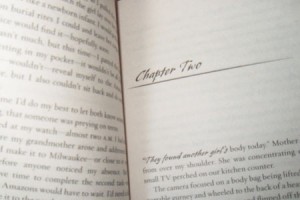Article One in How to Write a Scene, Scenes in Fiction by Lori Devoti, a How To Write Fiction Series.
When I first started writing I sat through a number of workshops where multi-published NY Times-best-selling authors would spout what are and aren’t scenes in fiction, and what could and couldn’t be in a book scene. I would leave confused and even a little angry. How could these people say these things? I had read countless books that had scenes that did exactly what they said couldn’t be done.
Then I realized something. We were using the same word (scene) for two different things.
There are scenes in fiction as most readers think of them–chunks of prose broken out on the page by either spaces or ### or *** and there are scenes as defined by Dwight Swain and others. These can be the same thing, but they aren’t necessarily.
 Scenes in fiction as a unit on the page
Scenes in fiction as a unit on the page
Scenes in fiction as a unit on the page (separated from other chunks by space, etc.) may actually be sequel (discussed later) or the same scene broken in two for point of view clarification or dramatic emphasis, or they may be scenes that are part of a sequence (defined later).
All of these things can be done, but so we are all using the same term unless otherwise noted, when using the term “scene” I will in this series be referring to the unit of story as defined by Swain.
Scenes in Fiction Defined
Dwight V. Swain in Techniques of the Selling Writer defines scene as “a unit of conflict, of struggle, lived through by character and reader. …a blow-by-blow account of somebody’s time-unified effort to attain an immediate goal despite face-to-face opposition.”
Broken down for emphasis scenes in fiction should:
- Have Conflict
- Be Lived through by Character and Reader
- Be Blow by Blow
- Have an Immediate Goal
- Contain Face-to-Face Opposition
Scenes need these things, or your book doesn’t need the scene.
He goes on to list the functions of scenes in fiction as:
1.) Providing Interest
2.) Moving Story Forward
How does a scene provide interest?
Go back to Swain’s definition or the first word I broke out. CONFLICT. Scenes and books must have conflict or there will be nothing to hold the reader’s interest. Conflict raises a question in the reader’s mind. Will the hero succeed? Will he fail? Will he make the right choice? Or the wrong? There are, of course, other ways to provide interest, but nothing is as compelling as conflict.
How does a scene move the story along?
What happens in the scene, your character’s success or failure at reaching his/her IMMEDIATE GOAL changes his situation which raises a new question and propels your reader into the next scene.
Having your character and the reader LIVE through the scene, BLOW BY BLOW, holds the scene together. It keeps the reader grounded and focused on what is happening to the character. Scenes are action; something must be happening. A scene is not summarization of what has happened. You may at times need to summarize, but this should be done sparingly and only with events that aren’t important to the main story question. If an event is important, show it in a scene.
Ever read a book where there was a huge build up to some important event, like the protagonist facing down the antagonist and when the time came, the author wimped out? Didn’t show you what happened, but instead glossed over the events, summarizing what had happened? Yeah, don’t do that.
On the reverse, if something is mundane like your character gets coffee and nothing important to the overall story happens–summarize! Because SCENES should MOVE THE STORY FORWARD.
Read the next article in How to Write a Scene series– Scene Structure: Goal, Conflict, Disaster
Need help with writing scenes in fiction?
~~~

Lori Devoti is the author of paranormal romance, urban fantasy and young adult fiction. Under the name Rae Davies, she writes the USA Today Bestselling Dusty Deals Mystery series. Check out her books at www.LoriDevoti.com and RaeDavies.com. Looking for help with your writing? Lori also does developmental editing and critiques for other authors and publishers. See our Editorial Services page for contact information and pricing.

Thankyou for sharing this lori, it will be a great help.
Do you still have to worksheet available. I’ve been finding all your articles very helpful
Hi, Abby-Rae. I’ll try and find it and email it to you. I just need to remember which worksheet it was. :)
Lori